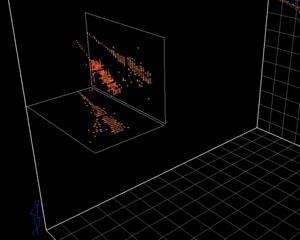NOvA neutrino detector records first 3-D particle tracks
What will soon be the most powerful neutrino detector in the United States has recorded its first three-dimensional images of particles.
 |
| This 3D image shows a cosmic-ray muon producing a large shower of energy as it passes through the NOvA far detector in Minnesota. Image courtesy NOvA collaboration. |
Using the first completed section of the NOvA neutrino detector, scientists have begun collecting data from cosmic rays--particles produced by a constant rain of atomic nuclei falling on the Earth's atmosphere from space.
The active section of the detector, under construction in Ash River, Minn., is about 12 feet long, 15 feet wide and 20 feet tall. The full detector will measure more than 200 feet long, 50 feet wide and 50 feet tall.
Scientists' goal for the completed detector is to use it to discover properties of mysterious fundamental particles called neutrinos. Neutrinos are as abundant as cosmic rays in the atmosphere, but they have barely any mass and interact much more rarely with other matter. Many of the neutrinos around today are thought to have originated in the big bang.
"The more we know about neutrinos, the more we know about the early universe and about how our world works at its most basic level," said NOvA co-spokesperson Gary Feldman of Harvard University.
Later this year, Fermilab, outside of Chicago, will start sending a beam of neutrinos 500 miles through the earth to the NOvA detector near the Canadian border. When a neutrino interacts in the NOvA detector, the particles it produces leave trails of light in their wake. The detector records these streams of light, enabling physicists to identify the original neutrino and measure the amount of energy it had.
When cosmic rays pass through the NOvA detector, they leave straight tracks and deposit well-known amounts of energy. They are great for calibration, said Mat Muether, a Fermilab post-doctoral researcher who has been working on the detector.
The detector at its current size catches more than 1,000 cosmic rays per second. Naturally occurring neutrinos from cosmic rays, supernovae and the sun stream through the detector at the same time. But the flood of more visible cosmic-ray data makes it difficult to pick them out.
Once the upgraded Fermilab neutrino beam starts, the NOvA detector will take data every 1.3 seconds to synchronize with the Fermilab accelerator. Inside this short time window, the burst of neutrinos from Fermilab will be much easier to spot.
Source: Fermi Lab website